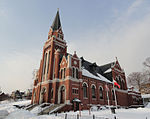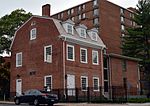Charter Oak Place
Historic districts on the National Register of Historic Places in ConnecticutNRHP infobox with nocatNational Register of Historic Places in Hartford, ConnecticutQueen Anne architecture in ConnecticutSecond Empire architecture in Connecticut ... and 1 more
Streets in Connecticut

Charter Oak Place is a street on the south side of downtown Hartford, Connecticut. Laid out in the 1860s, its residential character is in marked contrast to the commercial development that predominates around it. The street's buildings, constructed between the early 1860s and 1900, are a cross-section of Victorian architectural styles. The entire length of the street is listed on the National Register of Historic Places.
Excerpt from the Wikipedia article Charter Oak Place (License: CC BY-SA 3.0, Authors, Images).Charter Oak Place
Charter Oak Place, Hartford Downtown Hartford
Geographical coordinates (GPS) Address External links Nearby Places Show on map
Geographical coordinates (GPS)
| Latitude | Longitude |
|---|---|
| N 41.758055555556 ° | E -72.673333333333 ° |
Address
Charter Oak Place Historic District
Charter Oak Place
06106 Hartford, Downtown Hartford
Connecticut, United States
Open on Google Maps










